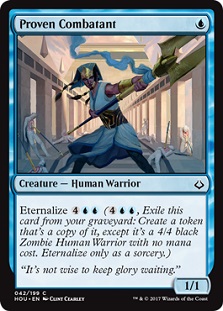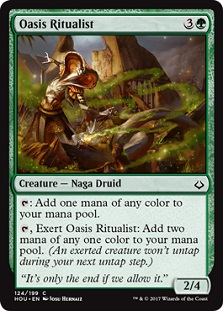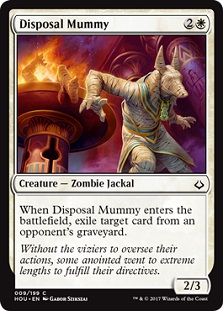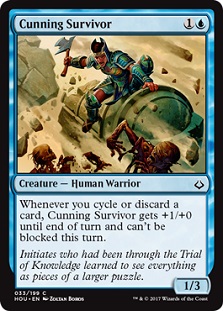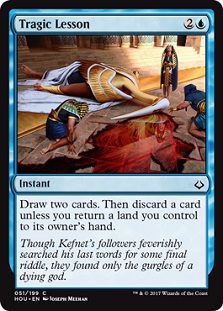The small set review is a dying breed. After Hour of Devastation, only Rivals of Ixalan remains as a second set in a block. I am not sure what this means for Pauper. On one hand, a large set more densely packed with on theme cards could mean new strategies are injected into the format with greater regularity. The increased demand on mechanics could give current fringe strategies a shot in the arm. There is a downside, however. The small set is a place where draft archetypes are fortified. Where a large set could give a fledgling deck a new card, the hope was the follow up would provide some upgrades. After Rivals, if a set falls short then it may be a long time before a new card emerges.
Hour of Devastation is fairly typical of a small set as it relates to Pauper. The power level, a potential victim of Kaladesh Standard, is rather low. There are quite a few cards that could find a home in a league or challenge decklist, but they are roleplayers rather than key elements. Much of this has to deal with the themes pushed at common: Desert matters and Eternalize.
There are a few Deserts worth including in a Pauper deck. The Cycle lands are outclassed by the previous versions from Urza’s Saga and Onslaught. The only time I could see running these, or running Survivors' Encampment over Holdout Settlement, is if another future set has better Desert matters cards. Sidewinder Naga is strong but does not warrant bending a deck to its will. Beyond that, nothing warrants a second look.
Steadfast Sentinel and Proven Combatant are the two commons with Eternalize. Neither of these are good enough on their front side. The opportunity to get a free 4/4, as in one that does not eat a card slot, is attractive. The question that has to be answered is if the uncounterable 4/4 is good enough to run a subpar creature. I want to like these cards and I want them to matter. Yet I think they are both too slow. The Combatant may find a home in Forbidden Alchemy or Thought Scour decks as a way to eke out an extra threat, but even then the body barely registers. If there are control mirrors where the last 4/4 matters, either of these could be reasonable sideboard inclusions. Right now, I think they are destined to exist on the edges of the format at best.
Firebrand Archer is a card that drew immediate comparisons to Thermo-Alchemist. It deals an extra damage for each instant or sorcery and falls at the same spot on the curve. Unlike Alchemist, its ability is not beholden to summoning sickness and it can crack in for two damage. These upsides come with a rather serious cost – a single point of toughness. The increased fragility matters as there are tons of effects that incidentally hose 1-toughness creatures. Augur of Bolas, a key inclusion in multiple decks, laughs the Archer and turns it into an Alchemist that also cannot block.
Thermo-Alchemist currently sees heavy play in Burn and some ![]()
![]() midrange decks as a way to help close out games. While I do not see Firebrand Archer replacing the Eldritch Moon standout in either of these decks I could see it in a more aggressive
midrange decks as a way to help close out games. While I do not see Firebrand Archer replacing the Eldritch Moon standout in either of these decks I could see it in a more aggressive ![]()
![]() deck that wants to leverage Delver of Secrets and burn like Lightning Bolt and Thunderous Wrath to construct a weapon that attacks on two axes.
deck that wants to leverage Delver of Secrets and burn like Lightning Bolt and Thunderous Wrath to construct a weapon that attacks on two axes.
Oasis Ritualist will almost certainly see play. Freed from the Real combo is a fan favorite in the format and this creature gives the deck a shot in the arm. In the past the deck needed to stick the eponymous aura on an animated land that could produce more than one mana. The combo was not vulnerable to a ton of removal since it would rely on Darksteel Citadel and Lifespark Spellbomb. Since Last Gasp and Grasp of Darkness are not regularly included in decks, then the land would often survive to generate an unbound amount of mana. Ritualist shrinks the combo so that it only needs the aura and creature. Both halves can be found be Benefaction of Rhonas meaning it is possible to run out Benefaction of turn three and set up both pieces for turns four and five. That is still asking a lot of the format as surviving to turn five with a lone creature in play is a big ask. Yet between Blue and Green there are a decent number of defensive elements that could conspire to have this become a more reliable archetype.
Freed Combo ? Pauper | Alex Ullman
- Creatures (12)
- 4 Elvish Mystic
- 4 Oasis Ritualist
- 4 Sakura-Tribe Elder
- Instants (13)
- 2 Moment's Peace
- 2 Muddle the Mixture
- 2 Pulse of Murasa
- 3 Vines of Vastwood
- 4 Impulse
- Sorceries (14)
- 2 Rolling Thunder
- 4 Benefaction of Rhonas
- 4 Preordain
- 4 Freed from the Real
- Lands (21)
- 7 Forest
- 7 Island
- 3 Simic Growth Chamber
- 4 Thornwood Falls
Ramp is a must as it allows Freed to come online a turn early. Green provides Moment's Peace to buy time, Pulse of Murasa to stitch the combo together, and Vines of Vastwood to protect the Ritualist. Muddle the Mixture and Train of Thought help us find the kill while the former lets us defends ourselves from certain forms of assault. This is far from a refined list but considering the recent success of combo decks in the Challenges, I would not be surprised to see a similar deck emerge in the coming weeks.
Staying in Green, we may have the most annoying card in the set in Life Goes On. Aggressive Green decks have already taken to running Feed the Clan as a way to change the race math. While the powered up mode of the Khans of Tarkir common is better by two life points it does have an additional generic mana in its cost. Life Goes On costs a single mana for the first four life and has an incredibly easy trigger for the second half. The ability is basically Morbid and gaining 8 life for a single mana is very swingy, especially when trading damage. Having a creature die is marginally easier than having a 4-power creature, even in a deck that is built around Rancor. Out of all the cards in Hour of Devastation, I am most confident in Life Goes On peppering sideboards for years to come.
Oketra's Avenger is the most annoying card that is not likely to see heavy play. Pauper has plenty of 3/1 creatures for ![]()
![]() but this is the first with some serious upside. A 3/1 that is impervious to combat damage every other turn is mediocre, but when evaluating White creatures it is important to look at them in the context of successful midrange White decks which all run Bonesplitter. A 5/1 with the same ability is better but still annoying. The axe wielding Avenger would trade with just about every heavily played creature and come out no worse for wear. Yet unlike Favored Hoplite this ability does not turn off all damage, just combat damage. Even when combined with the increasingly important Warrior synergy of Herald of Dromoka, the Avenger still falls flat.
but this is the first with some serious upside. A 3/1 that is impervious to combat damage every other turn is mediocre, but when evaluating White creatures it is important to look at them in the context of successful midrange White decks which all run Bonesplitter. A 5/1 with the same ability is better but still annoying. The axe wielding Avenger would trade with just about every heavily played creature and come out no worse for wear. Yet unlike Favored Hoplite this ability does not turn off all damage, just combat damage. Even when combined with the increasingly important Warrior synergy of Herald of Dromoka, the Avenger still falls flat.
There are very few creatures that exile a card from a graveyard upon entering the battlefield in Pauper. Gravegouger is probably the best, but even then its work can be undone by a Disfigure. Disposal Mummy does not have the Oblivion Ring clause and as such deserves examination. A ![]()
![]() for a 2/3 it is the right size for a utility creature. Kor Sanctifiers is more expensive for the full effect of a Disenchant. Considering how valuable the graveyard has been and looks to be in the format moving forward, the ability to commit a creature to the board while also garnering a small piece of card advantage should have an impact. It is hard to say that Disposal Mummy is true card advantage since it only eats a spent resource, but often it is these husks that help to fuel decks. Cards like Pulse of Murasa, Reaping the Graves, Archaeomancer, and Unearth all rely on having the correct cards in the discard pile. Finally there is a card that can leave an appreciable body behind — Beckon Apparition doesn’t count — while also sniping a key card. In Pauper, where the graveyard is the best source of tutor targets, the Mummy is a one use Surgical Extraction. That seems pretty good to me.
for a 2/3 it is the right size for a utility creature. Kor Sanctifiers is more expensive for the full effect of a Disenchant. Considering how valuable the graveyard has been and looks to be in the format moving forward, the ability to commit a creature to the board while also garnering a small piece of card advantage should have an impact. It is hard to say that Disposal Mummy is true card advantage since it only eats a spent resource, but often it is these husks that help to fuel decks. Cards like Pulse of Murasa, Reaping the Graves, Archaeomancer, and Unearth all rely on having the correct cards in the discard pile. Finally there is a card that can leave an appreciable body behind — Beckon Apparition doesn’t count — while also sniping a key card. In Pauper, where the graveyard is the best source of tutor targets, the Mummy is a one use Surgical Extraction. That seems pretty good to me.
Elusive Spellfist took some time to catch on but once it did it was crashing through for damage as fast as Ponder and Preordain could be cast. Cunning Survivor is a similar card that makes cards like Careful Study more attractive. Cunning Survivor makes it so that for every card thrown to a Wild Mongrel an extra point of damage is coming through. An updated version of a ![]()
![]() Wild Mongrel deck might look something like this:
Wild Mongrel deck might look something like this:
U/G Madness ? Pauper | Alex Ullman
- Creatures (21)
- 2 Merfolk Looter
- 3 Aquamoeba
- 4 Arrogant Wurm
- 4 Basking Rootwalla
- 4 Cunning Survivor
- 4 Wild Mongrel
- Instants (11)
- 3 Circular Logic
- 4 Rune Snag
- 4 Vapor Snag
- Sorceries (6)
- 1 Deep Analysis
- 1 Silent Departure
- 4 Careful Study
- Lands (22)
- 8 Forest
- 8 Island
- 2 Evolving Wilds
- 4 Thornwood Falls
Cunning Survivor also has the advantage of fitting into the combo deck du jour — Tireless Tribe combo. Speeding up the clock by a point per discard, the Survivor does have the advantage of having built in evasion. Being able to knock a full card off the kill turn is something, and may make it easier for the deck to survive removal based strategies.
Tragic Lesson is good. A largely unconditional instant speed draw two makes it easier for control decks to reload in the late game. The cost is far from negligible, as returning a land to your hand in the early game could be a death sentence on the metric of tempo. The upgraded Catalog, then, is more likely to see play in control decks as a late game option to either go up cards or rebuy a Bojuka Bog or Radiant Fountain. The Lesson also has strength in its hidden mode of turning off land destruction. Capsize and Dinrova Horror both regularly target a land and Tragic Lesson to fizzle both. In the case of Horror this turns off the discard element while in the case of Capsize it counters the card. In Tron decks featuring Prophetic Prism the instant could be used to save a key piece of the UrzaTron from Stone Rain or Earth Rift. If Life Goes On gets my award for most annoying card, Tragic Lesson gets the nod for most finicky.
There are some other cards from Hour of Devastation that merit mentioning without a deep dive.
- Crash Through is an option for Nivix Cyclops decks. It pumps the key creatures while also replacing itself. This is unlikely to replace Temur Battle Rage but finding home for one may be correct.
- God Pharaoh's Faithful looks like it should be a good blocker with upside yet the deck construction restraints to make it good enough are too high for it to be anything other than a fringe element.
- Countervailing Winds might as well be called Miscalculated Logic. The card would be great in control mirrors if those decks were running Bojuka Bog main. Even so it is strong enough to see play.
- Feral Prowler is a fine blocker that may be better than Elvish Visionary in Carrion Feeder decks. The ability to blank a 2-power creature while also being relevant later as a card matters. While it may not be enough to push the Aristocrats builds to the upper tier of Pauper it could give them a shot in the arm.
- Striped Riverwinder and Rampaging Hippo both work well with Exhume.
- Strategic Planning deserves a mention as it is a step forward in uniting the Paper and Online pool of commons.
Hour of Devastation is a fine set. Rather than overpowering us with Pauper playables, it gives the format a lot of nice tools. While an electric screwdriver is nice, sometimes you just need a good old phillips head.


















